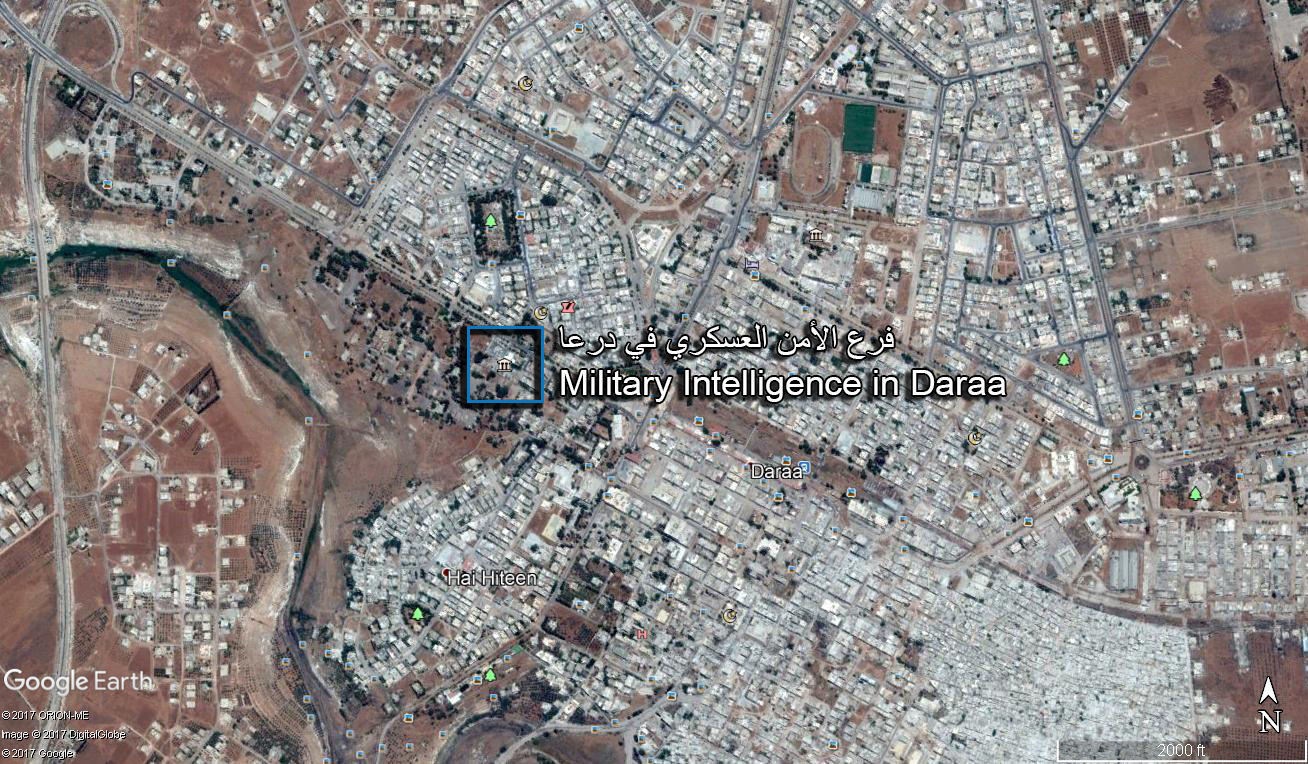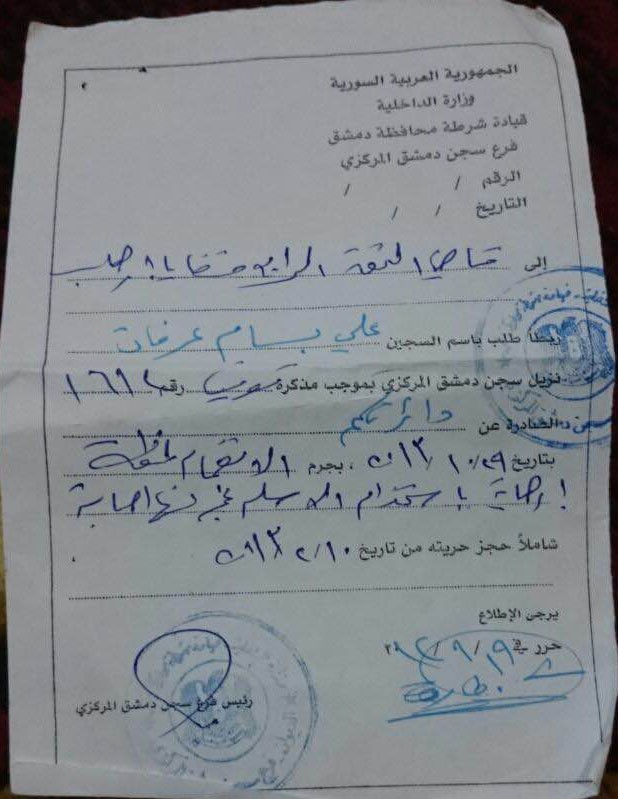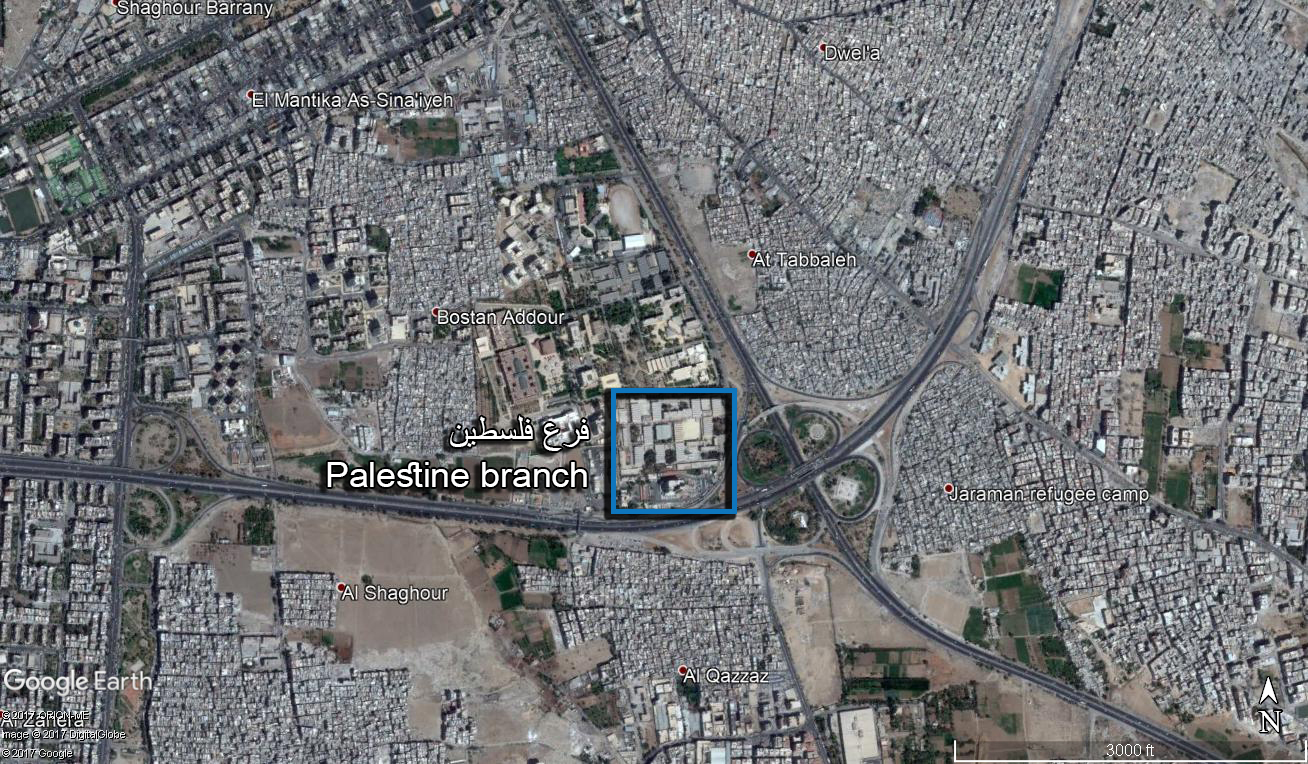Preface:
It was only hours after the detainee Ali Bassam Arafat was released from the Syrian Security Services Detention Facilities, to be arrested again on a Syrian regular forces checkpoint in Damascus, where he began a new journey of pain, agony, transfer between security branches, and spent another year on charges of terrorism. When he was released on August 13, 2015, he was shocked with a new tragic reality, as his father and brothers disappeared by the Syrian regular forces.
“During my detention period in the two branches (227) and Palestine branch (235) in Damascus, I was a witness to more than 500 bodies belonging to detainees who had died under torture. Besides I was subjected to various forms of torture, beginning from beating my whole body even the genitals with sticks, and ending with electrocution and hearing the laughter of the jailers overseeing my torture.”
With these words, the young man, Ali Arafat, briefed his suffering within the security branches in his testimony to STJ[1].
First, who is the Survivor Ali Bassam Arafat?
Ali Bassam Arafat, born in 1987 in Sbeneh town located in Damascus countryside; he is a breadwinner of a family and a parent of one child. He was one of the first to participate in the peaceful movement that spread across Syrian cities. On 18 October 2012, and following reports of the intention of Syrian security troops to storm the town backed by the Lebanese Hezbollah militia, he decided to flee with his family from Sbeneh, and did headed first to Zakyah town in Damascus countryside and then to Daraa Province, specifically to al-Harrah city. However, his father and brothers chose to stay in Sbeneh town. Ali started a hard journey to secure a living for his family, therefor, rented a car to transport goods between Ghabagheb and al-Harrah in the countryside of Daraa.
Second: The Initial Arrest and the Military Security Branch in Daraa
February 10, 2013, a military checkpoint of the National Defense Militia in Daraa arrested the young man Ali while he was transporting goods, in this regard he spoke to STJ, saying:
“When the members stopped me, they asked me if I had a weapon in the vehicle and I replied that I did not have any weapons; they immediately beat me with their fists and butts of the guns they were carrying until I almost fainted. They put me in front of the vehicle and said that I had been a terrorist and that I had to admit it otherwise they would liquidate me. I repeated that I had no knowledge of what they were talking about, so they beat me again, and then the officer-in-charge came and said that I had been a terrorist and a wanted for Damascus branches.”
The survivor Ali added that he was initially taken to a security center called “the Detachment” in As-Sanamayn where he remained for 15 days, during which he was subjected to beat with all sorts. After that, he was transferred to the Military Security Branch in Daraa, and once he arrived there, the electric baton was used on various parts of his body, almost a week later, he was summoned to investigation, where he continued saying:
“At midnight I was summoned for interrogation, immediately they put the blindfold on my eyes, and took me to the interrogation room, as soon as I entered, the interrogator said:” hey, the terrorist Arafat, welcome you, come on, tell me about the terrorist group you work with, how many are you, who finance you”. When I answered again in the negative, he started beating on my back with a heavy flexible green tool called “Lakhdar Brahimi”, and he beat my feet and limbs until they turned blue due to the violent hit. After he got tired of hitting me, he sat in his chair, called an operation center, and asked them “Is the terrorist Ali Arafat wanted for our security centers or for Damascus’?“
The survivor Ali continued that after the interrogation, he was taken back to a dormitory of no more than (4*4) meters, with up to 100 detainees. Concerning the food, it was some soup and uncooked rice, as well as little water that the detainees were often forced to bring from the toilet. Every week, the jailer used to enter the dormitory, gather the detainees in one corner and beat them severely under the pretext of hearing a sound coming from the dormitory. About a month later, the security officers handcuffed about 60 detainees, including Ali, put them in a closed vehicle, and told them that they were heading for Damascus.

A Satellite image shows the location of the Military Security Branch in Daraa Province, where the survivor Ali Arafat was subjected to various forms of torture during the interrogation.
Third: Damascus and the Security Box
Following the arrival of Ali with the rest of the detainees to Damascus, specifically to the security box that contain a series of security branches on 6th Ayar Street, near the Ministry of Higher Education, Ali was screened to branch (227). He spoke to STJ saying:
“As soon as I arrived the branch (227), I was placed in a room like a slaughterhouse of no more than (4*4)meters with many other detainees, one of them was hand amputated, and another one had lost one of his eyes, which indicated that they had been subjected to various forms of torture. There were about 50 detainees in that room, most of them were about to die due to the severe torture, when I saw those horrible scenes, I said to myself that it was my end, however, after a short period, they transferred me to the “tunnel”, a special place in which many detainees wait to be investigated.”
The young man Ali was summoned to the interrogation room where his suffering began again. He was beaten and two of his teeth were broken with a sharp instrument, then the interrogator came in with a chair called the German Chair and placed Ali on it in a certain way in order to break his spine, but the strong structure of Ali’s body prevented that. After that, he was taken to the basement room, where he was hanged from his hands and feet for half an hour in “Shabeh position”, then one of the agents started electrocuting him. In this regard, the survivor Ali said:
“They kept torturing me for more than two hours, and then took me to another room “collective room” that contained a group of detainees. Every day, they would torture me with various types to let me confess; they hanged my feet with a rope, put my head in a barrel of water, and took it out before I was choked. During my staying in the branch, I witnessed several cases of liquidations against detainees, mostly the young people who had not exceeded 40 years yet and who were from several provinces like Daraa, Damascus countryside and Homs. Two and a half months later, I was summoned by the interrogator who told me that I was innocent and that he would send my file to the head of the branch to release me.”
Ali said that a week after the investigating, another interrogator identified as Basil summoned him too; Ali had already heard about him from one of the interrogators, it was obvious from his dialect that he was from the Syrian coast. Immediately, the new interrogator insulted him and said: “I was reprimanded because of you; you have to admit that you are a terrorist working with an armed group.” Ali continued that the interrogator approached him, put his head inside a bag and tried to strangle him many times until he almost dead, and at this point the interrogator doubled the torture on Ali to extract some confession or even names. Ali said:
“I have a cousin identified as Rabe’e who was already arrested on a military checkpoint in Damascus on charges of belonging to armed gangs. Later, I learned that he was released during the period of my transferring between security branches. When the interrogator summoned me, he said that my cousin had confessed names of gunmen from the neighborhood where I live, and after being severely beaten, I admitted that those people were truly terrorists, and the interrogator asked me to confess that I was also a terrorist, but I refused. This situation lasted for about six months, every week the interrogator would summon me to give him more information, and in each time, he would give me little hope to release me, yet I did not confess anything about myself.”
Fourth: Investigation Branch (248)
Six months later, Ali was referred to the “Depository/Ida’a” Branch in Damascus, also known as the Investigation/Administration Branch No. 248, where he remained a whole month; the treatment of jailors was slightly better than the previous branch as it was limited to insults, as he described. After that, he was transferred to Military Judiciary, where he spent two days, then to Adra Central Prison, where he spent nearly nine months waiting for his trial session, Ali continued saying:
“I was not beaten nor tortured in Adra prison, but I was identified as “the terrorist” and always felt that I was being watched. Five months later, I was summoned to al-Faihaa Branch of the Political Security Division where they told me that there was a new confession of me. They interrogated me for three days, during which I was beaten by fists to give new names of terrorists, but I did not answer their questions, so they sent me back to Adra Prison, then I applied for release on bail which was approved by the Fourth Judge of the Counter Terrorism Court.”
 وفرع (248) في مدينة دمشق.jpg)
A satellite image shows the location of the branch (227) and the Investigation Branch (248) in Damascus, where the survivor Ali Arafat was transferred and investigated.

An image shows the application for release submitted by the survivor Ali Arafat to the fourth Judge of Counter Terrorism Court in Damascus on September 19, 2014.
Photo Credit: STJ
Fifth: The Ominous Release!
On 16 October 2014, the detainee, Ali Arafat, was released from Adra Central Prison, but on his way back to his home located in Sbeneh town in Damascus countryside, a military checkpoint run by the Syrian regular forces called “al-Bawaba” stopped him, asked for his identity card to be verified by “Tafiesh” process, and told him that he was wanted by a security branch. Ali tried hard to tell them that he was released only a few hours ago, but in vain; he was arrested again on charges of terrorism and, in this regard, Ali continued saying:
“I was transferred back to branch (227) where I stayed for a month without any investigation, until they summoned me and fastened my hands with iron shackles, and someone told me that my next transfer would be to branch (235), known as Palestine Branch affiliated to the Military Intelligence Department.”
Sixth: Back to Detention
As soon as the survivor Ali arrived at the Palestine branch, (235), he was beaten on the head by the butts of the gun, then taken down to an underground solitary confinement (2*1) meters with the number (17). Ali testified that there were approximately seven detainees in it with no toilet, and the food delivered was five olive beads or about (020 grams) of undercooked rice, about that Ali added:
“Almost every day, I heard from the solitary confinement next to mine that six detainees died, as one of the detainees who was code-named Ash-Shawish[2] called the jailer more than once saying: (Sir; someone returns the plate[3])|(Sir, someone gave back soul) an expression used when someone dies or about to die either because of the torture he exposed to by the interrogators or by one of the detainees among us whom are code-named Ash-Shawish, those who received orders to kill some detainees and were given more food as a reward, but in case they disobey orders, their lives became at stake. They were spreading horror in our hearts more than the jailers themselves because they were living among us.”
Seventh: Hundreds of Detainees Bodies Died in Detention Facilities
The survivor Ali added that the jailers often forced them to carry out the bodies from inside the solitary confinements and put them in a vehicle looked like a meat truck. Ali noted that during his detention in the two branches (227) and (235) -Palestine branch- in Damascus, he witnessed more than 500 bodies belonging to detainees who had died under torture, in this regard he continued saying to STJ:
“During my detention period in the two branches (227) and (235), I witnessed more than 500 bodies belonging to detainees who died under torture, and I was subjected to various forms of torture, from beating the whole body with sticks or even the genitals, and ending with electrocution and hearing laughter of the jailers overseeing my torture.”
Ali was detained at Branch (235)-Palestine Branch- for more than six months, and was released after he signed coerced confessions extracted under beating and torture. After that, he was transferred to the Military Police in Qaboun neighborhood and then to Adra Central Prison where he remained there for three months until he was summoned by the Fourth Judge of Counter Terrorism Court in al-Mezzeh region to ask him about the confessions he signed. Ali answered he confessed under torture, as a result, he was released again on 13 August 2015, when he directly headed to Daraa Province as he learned that his family had moved there. Ali continued in his testimony saying:
“When I met the rest of my family, I learned that both my brothers Mohammed and Ahmad had been killed by Syrian regular forces following its control on Sbeneh town in 2014, when an opposition faction stationed on the outskirts of Sbeneh committed a betrayal, as a result, the regime forces entered the town in cooperation with some opposition agents whom were secretly working with the latter. At the time, a sortie was carried out against most of the city’s inhabitants and my brothers were among those who were immediately liquidated because they resisted the entry of the security forces into Sbeneh town, according to accounts of most witnesses who managed to flee from the town.”
Ali added that his father was also arrested and killed by the Syrian regular forces when storming Sbeneh, citing the fact that when his family asked about his father at the Military Police Branch in Qaboun, one of the officers told them that he had a heart attack and died in detention, additionally, the officer gave them his identity card and the death certificate. Ali pointed out that his brother-in-law identified as Fadi Meqdad from Busra al-Sham located in Daraa Province also exposed to the same fate as his father in the same period.

A satellite image shows the location of Palestine Branch, also known as Branch (235) in Damascus, where the survivor Ali Arafat was transferred to and was subjected to various forms of torture, and witnessed the killing of many detainees under torture.
[1] A field researcher at STJ in Daraa province conducted the interview.
[2] A code-name given to the old detainees who have spent a long period in detention, and is also given to a detainee who sets himself up as head of the dormitory, or appointed by the security agents themselves,
[3] This term refers, in ordinary life, to the exit vehicles as cars and other out of service, as the plate are delivered to the government because of stop using them and being out of service.

